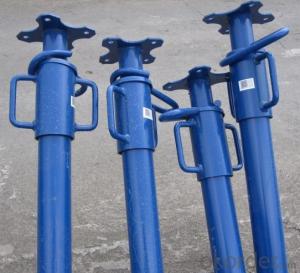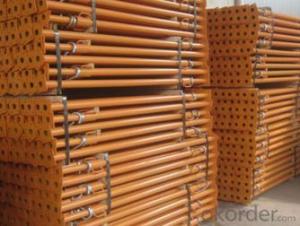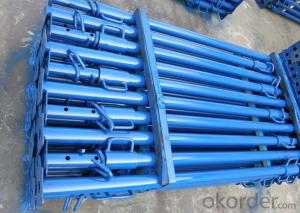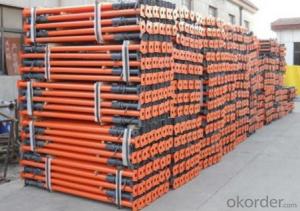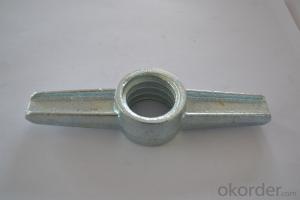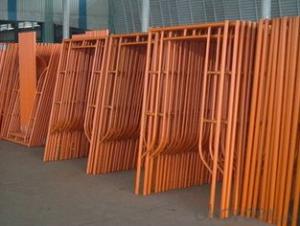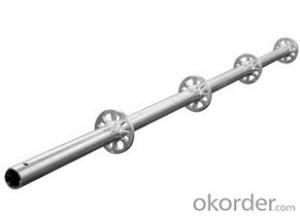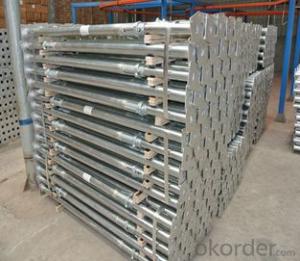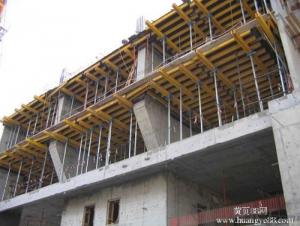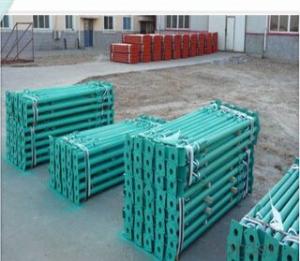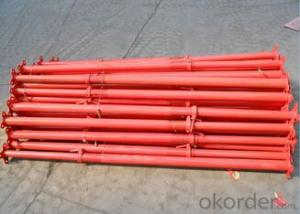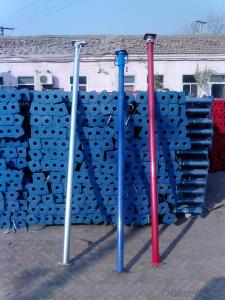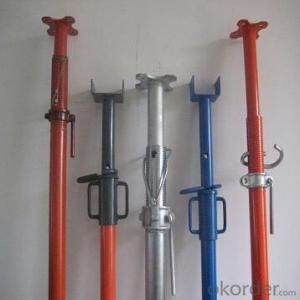adjustable Q235 /Q345 scaffolding steel prop for construction
- Loading Port:
- China Main Port
- Payment Terms:
- TT OR LC
- Min Order Qty:
- -
- Supply Capability:
- -
OKorder Service Pledge
OKorder Financial Service
You Might Also Like
| Model Number: | |||||
| Type: | Scaffolding Part Type: | materail: | |||
| surface: | outer pipe: | inner pipe: | |||
| plate: | packing: | MOQ: | |||
| Pressure load: |
Packaging & Delivery
| Packaging Detail: | in bulk or in pallets or as acquirement scaffolding steel prop |
| Delivery Detail: | About 15-20days one container scaffolding steel prop |
Specifications
scaffolding steel prop
1)Material: Q235;Q345
2)Surface:Electro galvanized;HDG; Powder coating,
3)ISO9001 cetificat
adjustable Q235 /Q345 scaffolding steel prop for construction
| Length | 1.8-3.1m/2.0-3.6m/2.2-4.0m/2.5-4.0m/3.0-4.8m (customizable) |
| Thickness | 1.6mm, 1.8mm, 2.0mm, 2.2mm, 2.5mm |
| InnerΦ | 40mm, 48mm |
| OuterΦ | 48mm, 56mm, 60mm |
| weight | 7.20kg-28.67kg |
1)Material:Steel Q235 Q345
2)Adjustable range:1.8-3.1m/2.0-3.6m/2.2-4.0m/2.5-4.0m/3.0-4.8m (customizable)
3)Inner&outerpipe specs:(customizable)
OD48*2mm/OD48*2.5mm/OD48*3mm/OD60*2mm/OD60*2mm/ OD60*2.5mm/OD60*3mm
4)Top&base plate:120*120*3mm/120*120*3.5mm/120*120*4mm/120*120*5mm
5Surface finish:painted/electro galvanized/hot dip galvanized/powder coated
6)Packing:in bulk or in pallet.
- Q: Does the basement steel frame support column need concrete pouring? Support column and floor junction practice?
- Usually, the anchor bolt and embedded steel 10 M24 thick steel plate, concrete floor to meet the design requirements after the strength, steel support column foot plate hole and embedded steel anchor bolts firmly, foot plate and embedded steel plate by welding welding
- Q: The exterior package aluminum plate, with steel support, about how much money.
- Inside the angle of the keel as an external wall, its accurate statement is a dry hanging operation technology, the price of this approach
- Q: Can steel props be used for supporting temporary residential structures?
- Yes, steel props can be used for supporting temporary residential structures. Steel props, also known as adjustable steel props or steel acrow props, are commonly used in construction projects to provide temporary support to structures. They are designed to bear heavy loads and provide stability during construction or renovation activities. For temporary residential structures, such as mobile homes, portable cabins, or temporary shelters, steel props can be an effective solution. They can be easily adjusted to the desired height and can provide the necessary support for the structure. Steel props are strong, durable, and have a high load-bearing capacity, making them suitable for various types of temporary residential structures. However, it is important to ensure that the steel props are properly installed and meet the specific requirements of the structure. Professional advice and expertise should be sought to determine the appropriate size, number, and placement of steel props to ensure the safety and stability of the temporary residential structure. Additionally, regular inspections and maintenance should be carried out to ensure that the steel props remain in good condition and continue to provide the necessary support. Overall, steel props can be a reliable choice for supporting temporary residential structures, but proper planning, installation, and maintenance are essential to ensure their effectiveness and safety.
- Q: How do steel props contribute to the stability of a structure?
- Steel props, also known as steel supports or steel shores, play a crucial role in enhancing the stability of a structure. These temporary structural elements provide support to existing structures during construction, renovation, or maintenance. By transferring the weight of the structure onto the props, they help distribute the loads evenly and prevent excessive deflection or collapse. Steel props effectively reinforce the structure, ensuring its stability and integrity throughout the construction process.
- Q: How do you ensure proper stability during seismic activities when using steel props?
- To ensure proper stability during seismic activities when using steel props, there are several measures that can be taken: 1. Design and engineering: The steel props should be designed and engineered to withstand seismic forces. This involves considering factors such as the expected magnitude of the seismic activity, the soil conditions, and the weight and height of the structure being supported. The props should be designed to have sufficient strength and stiffness to resist lateral forces and vibrations. 2. Proper installation: The steel props should be installed correctly and securely. This includes ensuring that they are installed on a stable and level foundation, and that they are properly braced and connected to the structure being supported. The props should be installed at the correct spacing and angle to provide adequate support and resistance to seismic forces. 3. Regular inspections and maintenance: Regular inspections should be conducted to check the condition of the steel props and ensure that they are still in good working order. Any signs of damage or deterioration should be addressed promptly. Additionally, any necessary maintenance or repairs should be carried out to ensure the continued stability and performance of the props. 4. Redundancy and backup systems: It is advisable to have redundant systems in place to provide additional stability during seismic activities. This can include using multiple steel props instead of relying on a single prop, or using alternative support systems such as concrete columns or shear walls in addition to steel props. These backup systems can help distribute the seismic forces and provide additional stability. 5. Compliance with building codes and regulations: It is important to ensure that the use of steel props during seismic activities complies with local building codes and regulations. These codes are designed to ensure the safety and stability of structures during seismic events. Compliance with these codes will help ensure that the steel props are properly designed, installed, and maintained to withstand seismic forces. Overall, ensuring proper stability during seismic activities when using steel props requires a combination of proper design, installation, inspection, maintenance, and compliance with building codes. By implementing these measures, the risk of failure or collapse during seismic events can be minimized, and the safety of the structure and its occupants can be ensured.
- Q: How do steel props compare to timber beams?
- Construction projects commonly utilize both steel props and timber beams, but they differ significantly in terms of their properties and applications. Strength and Load-Bearing Capacity: Steel props surpass timber beams in both strength and load-bearing capacity. Steel, being a much stronger material than wood, enables steel props to support heavier loads and provide increased stability and structural integrity. Durability: Steel exhibits high durability and resistance to environmental factors like moisture, pests, and rot. Consequently, steel props prove to be more reliable and long-lasting compared to timber beams. Conversely, timber beams are susceptible to decay, warping, and insect infestations, which can compromise their structural integrity over time. Versatility: Steel props offer greater versatility due to their adjustability and adaptability. Many steel props are telescopic, allowing for effortless height adjustment and accommodation of various construction needs. In contrast, timber beams are typically fixed in size and require extra effort for modifications. Fire Resistance: Steel is non-combustible and possesses high fire resistance, making steel props a safer choice in case of fire. Timber beams, being combustible, can contribute to fire spread and pose a greater fire safety risk. Cost: Generally, steel props are more expensive than timber beams due to higher material costs and the manufacturing process. However, the durability and longer lifespan of steel props may result in cost savings over time due to reduced maintenance and replacement needs. Environmental Impact: Timber beams are considered a more sustainable and eco-friendly option when compared to steel props. Timber is a renewable resource, whereas steel production requires significant energy and can generate more carbon emissions. However, the environmental impact depends on factors such as sourcing practices and responsible forestry management. Overall, steel props offer superior strength, durability, adjustability, fire resistance, and long-term cost-effectiveness. Timber beams, while more sustainable and potentially cost-effective initially, may require more maintenance and are less suitable for heavy load-bearing applications. The decision between steel props and timber beams ultimately hinges on specific project requirements, budget limitations, and environmental considerations.
- Q: Are steel props adjustable with hydraulic mechanisms?
- Steel props can indeed be adjusted using hydraulic mechanisms. In construction and formwork applications, hydraulic props are frequently utilized. These props are composed of a steel tube housing a hydraulic piston. The prop's height can be effortlessly and accurately adjusted by manipulating the hydraulic pressure. This facilitates swift and efficient installation and adjustment of support structures during construction. The construction industry favors hydraulic props due to their notable attributes such as durability, high load-bearing capacity, and user-friendliness.
- Q: What are the common safety training requirements for using steel props?
- The utilization of steel props necessitates adherence to several safety training requirements. These include: 1. Proper handling techniques: Training sessions should encompass safe lifting, carrying, and transporting of steel props to prevent strain and injury. This involves understanding weight limitations and utilizing appropriate lifting equipment when necessary. 2. Inspection and maintenance: Workers should receive training on inspecting steel props for signs of damage or deterioration before use. This entails checking for cracks, bends, rust, or any other defects that may compromise the structural integrity of the props. 3. Assembly and disassembly procedures: Proper training should be provided on correctly assembling and disassembling steel props. This entails understanding the correct sequence of components and ensuring secure connections. 4. Load capacity and weight distribution: Workers need to be educated on the maximum load capacity of steel props and how to evenly distribute weight to prevent overloading or instability. This knowledge is crucial for maintaining a safe working environment. 5. Stability and bracing: Training should emphasize the importance of providing adequate stability and bracing for steel props. Workers must understand how to properly secure props to prevent accidental collapse or movement during use. 6. Personal protective equipment (PPE): Safety training should include the requirement of wearing appropriate PPE, such as hard hats, safety goggles, gloves, and steel-toed boots, when working with steel props. 7. Emergency procedures: Workers should be trained on the appropriate emergency procedures in the event of accidents or incidents involving steel props. This includes knowing how to safely evacuate the area and administer basic first aid if necessary. In summary, safety training for the use of steel props should prioritize raising awareness, teaching proper handling techniques, and ensuring compliance with safety guidelines. This will help minimize the risk of accidents and injuries in the workplace.
- Q: Can steel props be used for supporting overhead cranes?
- Yes, steel props can be used for supporting overhead cranes. Steel props are known for their strength and stability, making them a suitable choice for providing support and ensuring the safe operation of overhead cranes.
- Q: Are steel props adjustable with remote control mechanisms?
- No, steel props are not typically adjustable with remote control mechanisms. They are usually manually adjusted by hand or with the use of mechanical tools.
Send your message to us
adjustable Q235 /Q345 scaffolding steel prop for construction
- Loading Port:
- China Main Port
- Payment Terms:
- TT OR LC
- Min Order Qty:
- -
- Supply Capability:
- -
OKorder Service Pledge
OKorder Financial Service
Similar products
Hot products
Hot Searches
Related keywords
